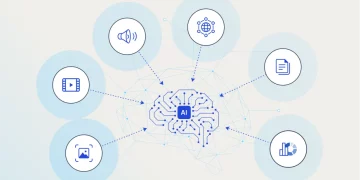Introduction
In the ever-evolving world of Artificial Intelligence (AI), the sheer number of available tools and platforms can be overwhelming. Every day, new AI resources emerge, each promising to streamline workflows, enhance creativity, and optimize processes across different industries. From AI-driven productivity tools to cutting-edge machine learning platforms, the options seem endless. However, not all AI resources are created equal, and finding the truly useful, high-performing, and innovative tools that meet your specific needs can be a daunting task.
So, how do you navigate this vast landscape and select AI tools that will truly add value to your work? In this article, we’ll dive into expert strategies and tips for filtering out the noise and choosing the best AI resources to maximize productivity and innovation. Whether you’re a business owner, developer, marketer, or simply a tech enthusiast, these guidelines will help you find the right AI tools to suit your goals.
1. Understand Your Objectives and Requirements
1.1 Define Your Needs Before Diving Into AI Tools
Before you start browsing through AI platforms and tools, it’s essential to first define what you want to achieve. AI is a broad field, and not every tool will be relevant to your specific situation. The first step in selecting the right AI resources is identifying the challenges you need to address and how AI can help solve them.
Key Questions to Ask:
- What problem am I trying to solve? Is it a process automation issue, data analysis challenge, customer engagement problem, or something else?
- What industry or domain am I working in? AI solutions can be vastly different depending on whether you’re in healthcare, retail, finance, education, or another field.
- What is my level of expertise? Are you a beginner looking for user-friendly tools or an experienced professional who needs more advanced functionalities?
By answering these questions, you’ll have a clearer vision of which type of AI tools will suit your needs. For example, a small business owner might focus on customer service automation (e.g., chatbots) while a data scientist might prioritize AI tools for data modeling and machine learning.
Tip: Prioritize your core objectives first. Whether it’s improving customer experience, automating administrative tasks, or optimizing workflows, identifying clear objectives will help narrow down your options.
2. Evaluate the Tool’s Usability and Accessibility
2.1 How Easy Is It to Use?
AI tools can range from simple, no-code platforms to advanced, technical solutions. Regardless of your expertise, you should always prioritize usability. A tool that is too complex or lacks a user-friendly interface will only slow you down and defeat the purpose of efficiency.
Questions to Consider:
- Ease of integration: Does the tool integrate seamlessly with your existing systems (e.g., CRM, analytics, databases)?
- Learning curve: How long will it take to learn and start using the tool effectively? Does it offer documentation, tutorials, and support?
- Customization: Can the tool be customized to fit your specific needs, or is it a one-size-fits-all solution?
Some AI tools, like Zapier for automation or ChatGPT for content generation, require minimal setup and can be used with little to no technical knowledge. Others, like TensorFlow or PyTorch, are designed for developers and require a deeper understanding of machine learning concepts.
Tip: Look for AI tools that offer a low learning curve, especially if you’re new to AI. Tools with intuitive interfaces and robust customer support will save you time and effort.
3. Assess the Innovation Factor
3.1 Is the Tool Truly Innovative, or Just a Trendy Copy?
While there’s no shortage of AI tools out there, it’s important to differentiate between truly innovative solutions and overhyped tools that don’t deliver on their promises. A tool might claim to use cutting-edge AI technology, but without a clear value proposition, it might not provide substantial benefits.
Key Signs of Innovation:
- Novel algorithms or methodologies: Does the tool leverage the latest advancements in AI, such as deep learning, reinforcement learning, or generative models?
- Unique use cases: Does the tool solve a problem in a way that existing tools don’t? Look for solutions that address unique or complex challenges.
- Scalability and flexibility: Does the tool have the potential to grow and adapt as your needs evolve over time?
AI tools like OpenAI’s GPT-3, Google’s AutoML, and RunwayML are examples of innovative resources that utilize state-of-the-art AI algorithms and have broad applications across industries. These tools are designed to solve problems in new ways and provide a high return on investment.
Tip: Evaluate the novelty of the tool. Look for tools that leverage the latest AI breakthroughs and offer solutions that are not only efficient but also capable of disrupting or enhancing your industry.
4. Prioritize Data Privacy and Security
4.1 Ensure the Tool Meets Privacy and Compliance Standards
As AI tools often deal with large volumes of sensitive data, ensuring that the tool you choose complies with data privacy regulations (such as GDPR or CCPA) is crucial. You don’t want to adopt a tool that jeopardizes your data security or exposes your company to compliance risks.
Security Questions to Ask:
- Data storage: Where does the AI tool store your data? Is it hosted in a secure location?
- Compliance: Does the tool adhere to relevant privacy laws and industry standards?
- Encryption and security protocols: Does the tool offer robust encryption, authentication, and other security measures?
Some platforms like Google Cloud AI and Microsoft Azure AI have built-in compliance frameworks that meet industry standards for security and privacy. This is especially important for sectors like healthcare, finance, and government.
Tip: Look for transparency in data handling and privacy policies. Ensure the tool provides clear information on how your data is protected.
5. Test the Tool with a Trial or Demo
5.1 Don’t Commit Without Trying It Out
Before committing to any AI tool, always take advantage of free trials, demos, or test versions to evaluate its effectiveness in a real-world scenario. This allows you to assess the tool’s usability, performance, and overall fit for your specific needs.
Steps to Take:
- Sign up for a demo: Most AI tools offer free trials or live demos. Use this opportunity to explore the tool’s features and capabilities.
- Evaluate performance: Test how the tool performs under your normal working conditions. Does it meet your expectations in terms of speed, accuracy, and ease of use?
- Assess customer support: Reach out to customer service during the trial period to evaluate the level of support available. A responsive support team can make a big difference in your experience with the tool.
Tip: Test a few options: Don’t settle for the first AI tool you come across. Testing several tools will help you compare performance, ease of use, and features.

6. Check for Scalability and Long-Term Viability
6.1 Will the Tool Grow With You?
The best AI tools aren’t just good for solving current problems—they should also be scalable to accommodate future needs. Consider how the tool will fit into your long-term strategy.
Scalability Factors to Consider:
- Growth potential: Does the tool have the ability to handle increased demand as your business or project grows?
- Customization: Can the tool be easily adapted or enhanced with new features as your needs evolve?
- Support for future advancements: Is the tool regularly updated with new AI advancements, or does it feel stagnant?
AI platforms like AWS AI, Google AI, and IBM Watson are designed to grow with your business, offering a wide range of tools and integration options that can scale over time.
Tip: Choose tools that offer flexibility and scalability to ensure they remain relevant and effective as your needs change.
7. Check for Community and Ecosystem Support
7.1 Leverage the Power of a Strong AI Community
AI is a rapidly advancing field, and tools that are backed by strong developer communities and ecosystems tend to be more reliable and innovative in the long run. A large community can offer valuable resources, such as tutorials, documentation, code snippets, and troubleshooting advice.
Key Indicators of a Strong Community:
- Active forums and user groups: Does the tool have a strong presence in online forums (e.g., Stack Overflow, Reddit, GitHub)?
- Robust documentation: Is there extensive documentation, tutorials, and user guides available?
- Third-party integrations: Does the tool integrate with popular tools or platforms (e.g., Zapier, Slack, GitHub)?
Popular tools like TensorFlow, PyTorch, and Scikit-learn are known for their strong developer communities and rich ecosystems, which make it easier to get help and stay updated with the latest features.
Tip: Choose tools with active user bases and community support to help you stay ahead of potential challenges and learn from others’ experiences.
Conclusion
Finding the right AI tools in a sea of options requires a thoughtful and strategic approach. By understanding your goals, evaluating usability, and ensuring security and scalability, you can filter out ineffective tools and focus on those that truly add value. Additionally, testing, customization, and leveraging the power of AI communities can help you make the most of your chosen platform.
AI is a game-changer, but only if you choose the tools that align with your specific needs and objectives. By following the expert recommendations above, you can confidently identify and adopt the most innovative, efficient, and useful AI resources to propel your work or business forward.











































